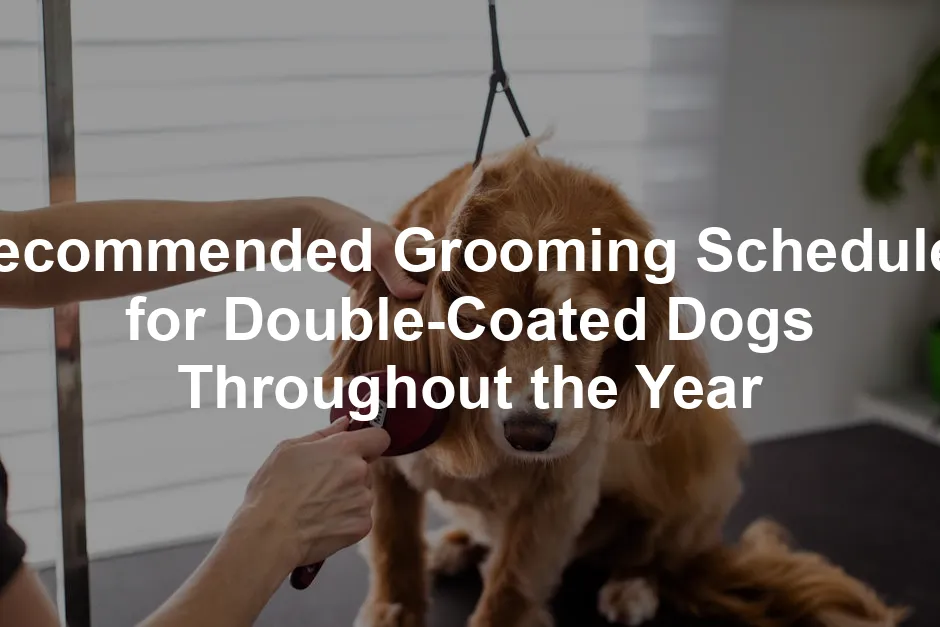Introduction
Double-coated dogs are like the fluffy superheroes of the canine world. They come with a built-in insulation system, ready to take on any weather. But let’s be honest: owning one is akin to signing up for a full-time job. If you think you’ve got it tough with your daily grind, try battling the relentless shedding of a Siberian Husky or a Golden Retriever. Yes, it’s a noble endeavor, but your vacuum cleaner might just become your new best friend. The importance of grooming for these fluffy companions cannot be overstated. Regular grooming helps prevent matting, keeps their skin healthy, and ensures they don’t resemble walking dust bunnies. As your dog’s personal stylist, you’ll want to keep their coat looking fabulous year-round. This article will provide you with a comprehensive guide to grooming schedules tailored to different seasons and shedding cycles, so you can maintain that luxurious double coat while keeping your sanity intact. Are you ready to tackle the hair-raising task of grooming? Fear not! We’ll break it down into manageable chunks. From spring’s shedding frenzy to winter’s coat maintenance, we have a plan that will help keep your furry friend— and your home— looking their best. So grab your brushes, and let’s dive into the world of grooming double-coated dogs!Summary of Key Points
Double-coated dogs boast a unique fur structure that consists of two layers: a soft undercoat and a protective top coat. This combination is designed to provide insulation and protect them from the elements. Breeds such as the Siberian Husky, Golden Retriever, and German Shepherd fall into this category, each with its own grooming demands. Regular grooming is essential for these dogs. It helps to prevent matting and skin issues that can arise if the undercoat isn’t properly maintained. During grooming sessions, you’ll be amazed at how much fur can accumulate—especially during shedding seasons. Double-coated dogs typically “blow” their coat in spring and fall, leading to a significant increase in hair loss during these times. Understanding the seasonal shedding patterns is crucial for creating an effective grooming schedule. For instance, spring may require more frequent grooming to manage the massive fur fallout. Meanwhile, in winter, grooming focuses on maintaining the coat’s insulation properties without excessive disruption. What’s next, you ask? Well, our article will dive deeper into the specific grooming techniques and tools you’ll need for each season. Get ready to learn the ins and outs of keeping your double-coated friend looking fresh, fluffy, and fabulous all year long!
Understanding Double-Coated Dogs
Definition of Double-Coated Dogs
Double-coated dogs boast a unique fur structure that truly sets them apart. Their coats consist of two distinct layers: the undercoat and the top coat. The undercoat is a soft and dense layer of fur that provides insulation and warmth. Think of it as a cozy blanket—perfect for chilly days! The top coat, often longer and coarser, acts as a protective barrier against dirt and moisture. This dynamic duo not only keeps your dog comfy but also helps regulate their body temperature, making them resilient in various weather conditions.Common Breeds
Many beloved dog breeds come equipped with this double coat. Some of the most popular include:- Siberian Husky: Known for their striking blue eyes and playful demeanor, these dogs are built for cold climates. Their thick fur keeps them warm and fluffy year-round.
- Golden Retriever: Famously friendly, Goldens have a feathered coat that requires regular grooming. Their double coat makes them equally adept at cooling off in summer and staying warm in winter.
- German Shepherd: Intelligent and loyal, these dogs have a thick double coat that sheds significantly. They need consistent grooming to keep their fur in check.
- Chow Chow: With a lion-like mane, Chow Chows are distinct. Their double coat is dense and requires diligent maintenance to avoid matting.
Grooming Challenges
Grooming double-coated dogs might feel like trying to untangle a ball of yarn, but with the right approach, it’s manageable. One of the most significant challenges is shedding. These fluffy companions shed their undercoat twice a year, resulting in a seemingly endless supply of fur on your floors and furniture. Matting can also be an issue if regular grooming isn’t maintained. The undercoat can become tangled and compressed, leading to discomfort for your furry friend. Additionally, double-coated dogs can be prone to skin issues if their coats are not properly cared for. Moisture and debris can become trapped, leading to hot spots or infections. Regular grooming helps to remove loose hairs, dirt, and dead skin, promoting a healthy coat and skin. So, while owning a double-coated dog is a delightful experience, it does come with its fair share of grooming hurdles! But fear not; with a consistent grooming routine, you can keep your furry friend looking fabulous and feeling great all year round.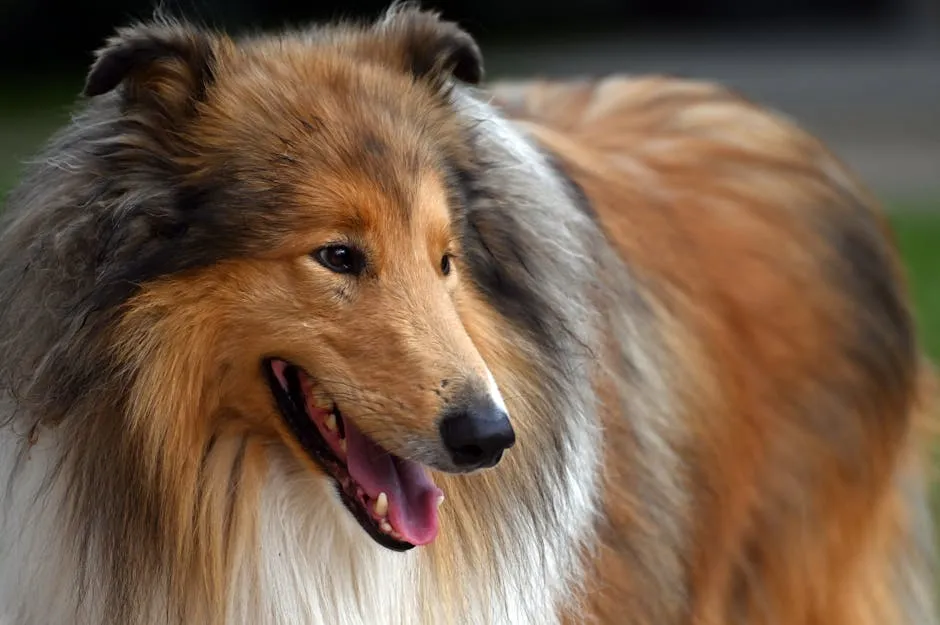
Summer
**Activities** Summer is that glorious time when the sun shines, and the world feels alive. But for double-coated dogs, it can be a bit of a hairy situation—literally! As temperatures rise, maintaining your pup’s coat health becomes crucial. Their fluffy undercoat can trap heat, leading to discomfort and potential matting. Imagine wearing a fluffy sweater on a sweltering day; not fun, right? Regular grooming helps prevent that dreaded scenario while keeping your dog cool and comfortable. **Recommended Grooming Schedule** During summer, aim for bi-weekly brushing. This rhythm keeps loose hair at bay and prevents it from forming mats. Consider using a slicker brush or an undercoat rake to get to the root of the problem—literally! If you’re looking for a reliable grooming tool, the Furminator Undercoat Deshedding Tool is a fantastic option. It effectively removes loose fur without damaging your dog’s top coat. Professional grooming every 6-8 weeks is also recommended. It’s like a spa day for your furry friend, ensuring they look fantastic and feel refreshed. Don’t forget to emphasize hydration! Keeping your pup’s skin healthy is just as important as maintaining their coat. A cool drink after a grooming session? Yes, please!Autumn
**Activities** As summer fades, autumn brings a beautiful change. Leaves fall, and so does your double-coated dog’s undercoat! This time of year is all about preparing for winter coat growth. With the increase in shedding, you’ll want to ensure your furry friend doesn’t turn into a walking fur tornado. Regular grooming will help you manage this transition and keep your home fur-free. **Recommended Grooming Schedule** In autumn, aim for weekly brushing sessions. This frequency helps capture all that pesky shedding fur before it takes over your living room. Along with brushing, schedule professional grooming every 4-6 weeks. Using de-shedding tools can significantly ease the shedding process. Think of it as a mini autumn clean-up for your pooch. With the right routine, you can both enjoy the crisp air without the added furball drama!Winter
**Activities** Winter is here, and your double-coated dog’s fur is ready to shine! Their coat provides excellent insulation, but it also requires some TLC during the colder months. While shedding is minimal, regular grooming is essential to maintain coat health and prevent moisture-related issues. Think of your dog’s fur as a warm blanket; it needs care to keep its warmth intact! **Recommended Grooming Schedule** In winter, a monthly grooming session should suffice. This schedule allows you to maintain the integrity of their coat while keeping it clean and mat-free. Pair this with bi-weekly brushing to remove any loose hairs and dirt that might cling to their fluffy fur. Remember, moisture can be a foe for double-coated dogs. So, consider protective measures against excess moisture, like drying them thoroughly after walks in the snow. Keep your pup cozy and their coat looking fabulous!Essential Grooming Techniques and Tools
Brushing Techniques
Brushing your double-coated dog is crucial, and it involves two layers. Start with the undercoat. Use an undercoat rake or a slicker brush to reach that fluffy layer. This helps remove loose hair and prevents matting. For the top coat, a bristle brush works wonders. It smooths the hair and distributes natural oils. Make sure to brush in the direction of hair growth. This not only feels nice but also prevents tangles. Remember, regular brushing keeps their coat looking fabulous and reduces shedding.Bathing Guidelines
Bathing should be part of your grooming routine, but don’t overdo it. For double-coated dogs, a bath every 4-6 weeks is usually enough. Use a high-quality dog shampoo that’s gentle on their skin. Look for products designed for double-coated breeds. These shampoos help maintain the coat’s natural oils while cleansing. After the bath, a conditioner can be beneficial. It helps detangle and soften the fur, making brushing easier afterward. Try the Earthbath All Natural Pet Shampoo, which is perfect for maintaining that luxurious coat while being gentle on their skin.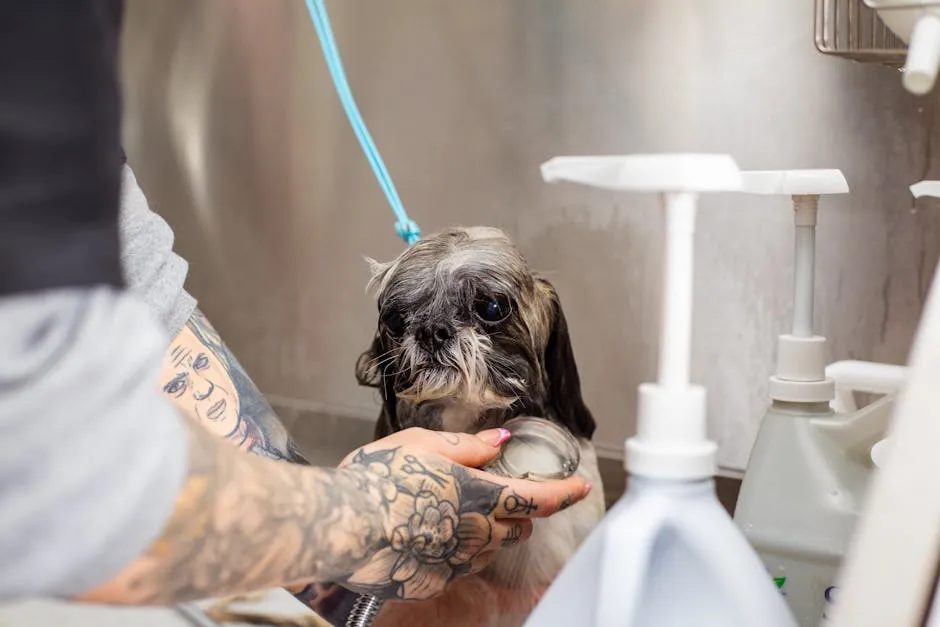
Deshedding Tools
Deshedding tools are your best friends during shedding season. One of the top choices is the Furminator. This tool is specially designed for double-coated breeds. It effectively removes loose undercoat fur without damaging the top coat. When using it, work in sections and be gentle to avoid pulling on the skin. Other options include grooming combs and undercoat rakes. These tools can help minimize the amount of hair left on your floors, furniture, and, let’s face it, everywhere!Additional Care
Grooming isn’t just about brushing and bathing. Don’t forget about nail trimming and ear cleaning. Regular nail trims prevent overgrowth and discomfort. Aim for every 3-4 weeks. For ear cleaning, use a vet-approved solution like TropiClean Ear Cleaner for Dogs to keep them free from wax and debris. It’s also a great opportunity to check for skin issues. Look for any bumps, redness, or unusual odors. Addressing these problems early can save you and your dog from future discomfort.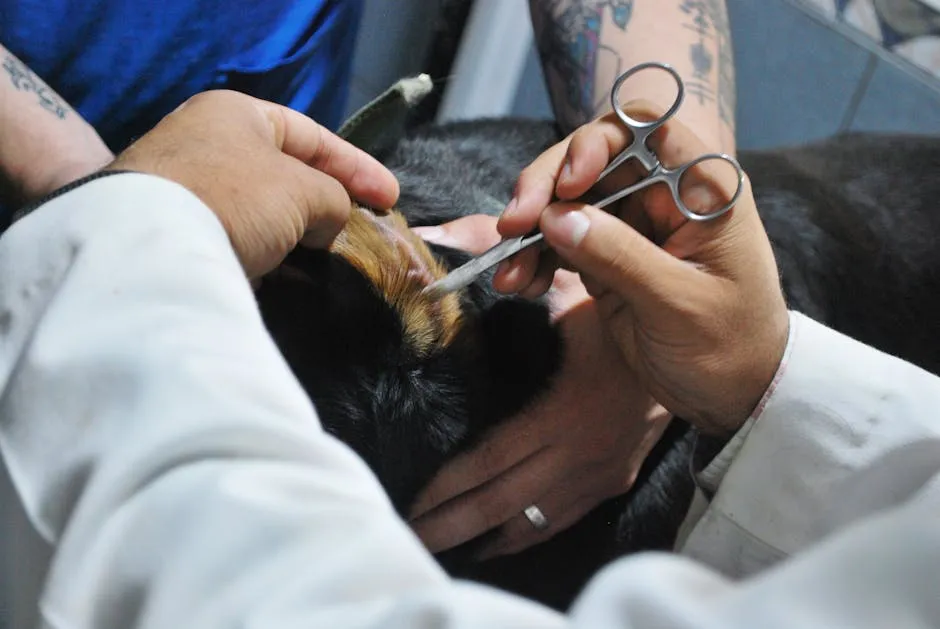
Best Practices for Home Grooming
Daily/Weekly Routines
Establishing a grooming routine at home can make a world of difference. Brush your double-coated dog at least once a week, increasing frequency during shedding seasons. This helps keep their coat healthy and minimizes hair around your home. Incorporate a quick check for mats or tangles during brushing. A little extra attention can prevent bigger issues down the road. If your dog enjoys baths, consider a gentle wash every 4-6 weeks to maintain coat health. And for those nail trims, Dog Nail Clipper and Trimmer is essential for keeping their paws healthy!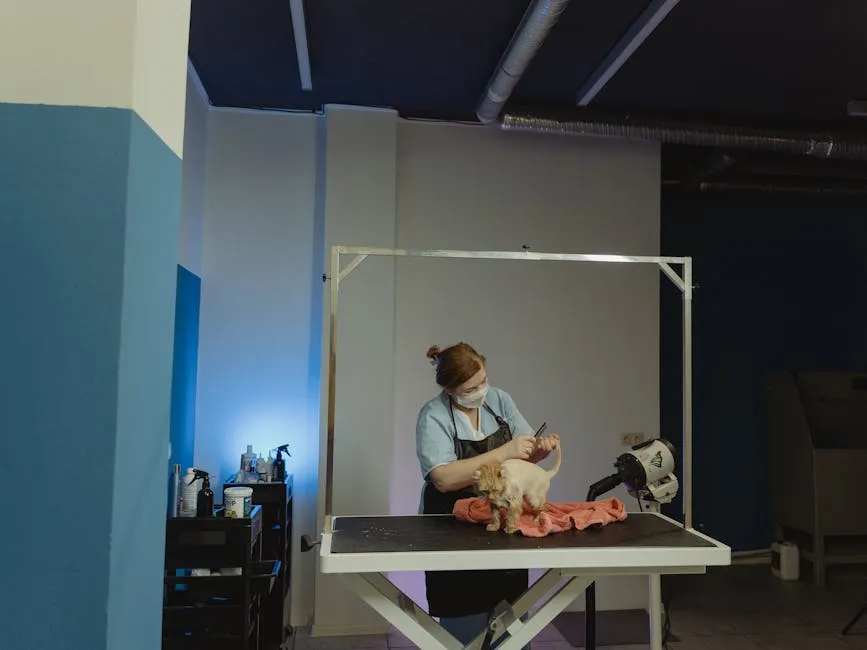
Tips for Reducing Shedding
To tackle shedding effectively, consider your dog’s diet. Ensure they’re eating high-quality food rich in omega fatty acids. These nutrients promote healthy skin and a shiny coat. Regular grooming helps, but a well-balanced diet can reduce the amount of fur floating around. Additionally, hydration is key. Make sure your pup has access to fresh water at all times. A healthy dog is less prone to excessive shedding, keeping your home fur-free and your furry friend feeling fabulous! You might also want to try Zesty Paws Omega 3 Fish Oil for Dogs to boost their overall health.Conclusion
Grooming double-coated dogs isn’t just a task; it’s a commitment to ensuring your furry friend remains healthy and comfortable year-round. Consistent grooming prevents matting, reduces shedding, and helps maintain healthy skin. A well-groomed dog is not just a happy dog, but also one that looks fabulous. Adopting the recommended grooming schedules for each season will help you stay ahead of the shedding and keep your home fur-free. Remember, grooming is not just about aesthetics; it’s essential for your dog’s overall well-being. So, grab those brushes and make grooming a delightful routine for you and your pup! We’d love to hear from you! Share your grooming experiences and tips in the comments below. Let’s swap stories and tricks to keep our double-coated companions looking their best!FAQs
How often should I groom my double-coated dog?
Grooming frequency varies by season and breed. Generally, you should brush your dog at least once a week. During shedding seasons, you might need to brush daily. Professional grooming is recommended every 4-8 weeks, depending on the breed and shedding cycle.
Can I shave my double-coated dog in summer?
Shaving is not recommended for double-coated breeds. Their double coat acts as insulation, keeping them cool in summer and warm in winter. Shaving can lead to skin issues, disrupt natural temperature regulation, and may even cause permanent coat damage.
What are the best grooming tools for double-coated dogs?
Key grooming tools include: – **Undercoat rake**: Great for removing loose undercoat hair. – **Slicker brush**: Ideal for the top coat, helping to smooth and detangle. – **De-shedding tool (e.g., Furminator)**: Efficient for managing shedding. – **Grooming comb**: Helpful for tackling tangles and mats.
How can I manage shedding at home?
Managing shedding involves regular grooming and a few practical tips: – Brush your dog frequently, especially during shedding seasons, to remove loose hair. – Invest in a high-quality vacuum cleaner designed for pet hair. – Use lint rollers or pet hair removers on furniture and clothing. – Maintain a healthy diet for your dog; proper nutrition can improve coat health and reduce shedding.
For effective grooming, check out our guide on how to groom double-coated dogs to reduce shedding.
To enhance your grooming experience, consider using budget-friendly dog grooming tools for home use.
All images from Pexels

